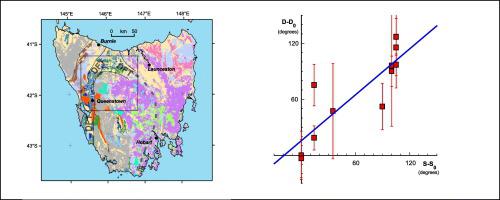当前位置:
X-MOL 学术
›
Tectonophysics
›
论文详情
Our official English website, www.x-mol.net, welcomes your
feedback! (Note: you will need to create a separate account there.)
Palaeomagnetism of the Dundas–Fossey Trough, Tasmania: Oroclinal rotation and Late Cretaceous overprinting
Tectonophysics ( IF 2.7 ) Pub Date : 2020-07-01 , DOI: 10.1016/j.tecto.2020.228453 Robert J. Musgrave , Kathryn Job
Tectonophysics ( IF 2.7 ) Pub Date : 2020-07-01 , DOI: 10.1016/j.tecto.2020.228453 Robert J. Musgrave , Kathryn Job

|
Abstract The Dundas–Fossey Trough, a curved belt of Early Palaeozoic rocks in western and northern Tasmania, is hypothesised to have developed as an orocline driven by asthenospheric flow behind a rapidly retreating subduction zone on the East Gondwana margin. Rocks of the Wurawina Supergroup from the trough were sampled for a palaeomagnetic test of this hypothesis. Rock magnetic analysis identifies both magnetite and hematite remanence carriers. Hematite carries a normal-polarity overprint which was acquired at relatively low temperature. Thermal demagnetisation over the magnetite unblocking range reveals a linear trend that defines component A, which displays both normal and reversed polarity. Component A passes a modified version of the fold test, indicating that it is pre-deformational. The declination of component A correlates linearly with regional strike, thus passing the orocline test. A palaeomagnetic pole for the Cambrian Owen Group, after correction for oroclinal rotation, is displaced from the Gondwana polar wander path, suggesting that the western limb of the trough may have been rotated anticlockwise by about 40° prior to the development of the orocline, presumably during known Early to Middle Ordovician deformation. Adjustment of the palaeomagnetic declination data to account for this earlier phase of rotation improves the fit parameters of the orocline test. The palaeomagnetic results are consistent with the orocline model for the Dundas–Fossey Trough, and support the inference that the trough extends beneath later cover in southeastern Tasmania. Overprint component B yields a mean pole in broad agreement with other overprints previously observed both in Tasmania and the eastern seaboard of the Australian mainland, and like them appears to have been acquired during the Late Cretaceous normal polarity superchron. We speculate that magnetic overprinting in Tasmania is related to enhanced oxidation by meteoric water driven by regional uplift.
中文翻译:

塔斯马尼亚 Dundas-Fossey 海槽的古地磁:正倾旋转和晚白垩世叠印
摘要 Dundas-Fossey 海槽是塔斯马尼亚西部和北部的一条早古生代岩石的弯曲带,被假设是在东冈瓦纳大陆边缘快速后退的俯冲带后面由软流圈流驱动的斜斜线。对来自海槽的 Wurawina 超群的岩石进行了采样,以对这一假设进行古地磁测试。岩石磁性分析可识别磁铁矿和赤铁矿剩磁载体。赤铁矿带有在相对较低温度下获得的正常极性叠印。在磁铁矿解锁范围内的热退磁显示出定义组件 A 的线性趋势,它显示正常和反向极性。组件 A 通过了折叠测试的修改版本,表明它是预变形的。分量A的偏角与区域走向呈线性相关,因此通过了orocline测试。寒武纪欧文群的一个古地磁极,在修正口斜旋转后,偏离冈瓦纳极地漂移路径,这表明槽的西翼可能在口斜发育之前逆时针旋转了大约 40°,推测在已知的早到中奥陶世变形期间。调整古地磁偏角数据以说明旋转的早期阶段改进了斜斜试验的拟合参数。古地磁结果与 Dundas-Fossey 海槽的orocline 模型一致,并支持海槽延伸到塔斯马尼亚东南部较晚的覆盖之下的推论。叠印组分 B 产生的平均极点与先前在塔斯马尼亚和澳大利亚大陆东部沿海观察到的其他叠印大体一致,并且与它们类似,似乎是在晚白垩世正常极性超时获得的。我们推测塔斯马尼亚的磁性叠印与区域隆起驱动的大气水氧化增强有关。
更新日期:2020-07-01
中文翻译:

塔斯马尼亚 Dundas-Fossey 海槽的古地磁:正倾旋转和晚白垩世叠印
摘要 Dundas-Fossey 海槽是塔斯马尼亚西部和北部的一条早古生代岩石的弯曲带,被假设是在东冈瓦纳大陆边缘快速后退的俯冲带后面由软流圈流驱动的斜斜线。对来自海槽的 Wurawina 超群的岩石进行了采样,以对这一假设进行古地磁测试。岩石磁性分析可识别磁铁矿和赤铁矿剩磁载体。赤铁矿带有在相对较低温度下获得的正常极性叠印。在磁铁矿解锁范围内的热退磁显示出定义组件 A 的线性趋势,它显示正常和反向极性。组件 A 通过了折叠测试的修改版本,表明它是预变形的。分量A的偏角与区域走向呈线性相关,因此通过了orocline测试。寒武纪欧文群的一个古地磁极,在修正口斜旋转后,偏离冈瓦纳极地漂移路径,这表明槽的西翼可能在口斜发育之前逆时针旋转了大约 40°,推测在已知的早到中奥陶世变形期间。调整古地磁偏角数据以说明旋转的早期阶段改进了斜斜试验的拟合参数。古地磁结果与 Dundas-Fossey 海槽的orocline 模型一致,并支持海槽延伸到塔斯马尼亚东南部较晚的覆盖之下的推论。叠印组分 B 产生的平均极点与先前在塔斯马尼亚和澳大利亚大陆东部沿海观察到的其他叠印大体一致,并且与它们类似,似乎是在晚白垩世正常极性超时获得的。我们推测塔斯马尼亚的磁性叠印与区域隆起驱动的大气水氧化增强有关。











































 京公网安备 11010802027423号
京公网安备 11010802027423号